Camino Portuguese: Porto to Santiago
- hm
- Apr 14
- 17 min read

In April 2025, three longtime friends—me included—set out to walk the 280 km Camino Portuguese from Porto, Portugal to Santiago de Compostela, Spain. This was a follow-up to my solo Camino Frances trek in 2024, a journey of 850 km across northern Spain. This time, with over thirty years of friendship between us, camaraderie was at the heart of our adventure.

The trip began with the usual chaos that budget airlines can inspire. RyanAir demanded a series of app-based steps just to issue a boarding pass, and their verification process was maddeningly slow, filled with glitches and payment woes.
My AT&T phone struggled to maintain a signal, and American credit cards repeatedly failed. PayPal saved the day, though the process—passport scans, live selfies, blinking exercises—took nearly 40 minutes. Eventually, I cleared security, handed off my checked bag, and boarded what felt like the world’s least user-friendly flight.

Next morning, first things first, we stepped into a restaurant and had the pastel de nata and Croquetas de Bacalao.

We had arrived in Porto ready to walk, though logistics still had us tangled. Extra luggage had to be sorted, and the cathedral at the starting point—Sé Cathedral—offered little help. A local travel operator stepped in, agreeing to hold our bags for €50 until we returned after our journey.

With that sorted, we donned ponchos and stepped out in the rain, met by cheering tourists delighted to see “real” pilgrims. We took the beautiful rainbow in the sky as a good omen on the start of our long trek.

We walked beside the Douro River, past port distilleries and breezy cafés, before indulging in pastries with Atlantic views at Foz do Douro.
It was a long slog, and we had a late start. To plan the future days better, we decided to start early the next day. For today, we decided to not stop anymore until we reached our destination.
As we came to a busy bridge connecting the Douro river to the Atlantic Ocean, we got to enjoy the opening of the drawbridge, and a huge ship passed underneath it.
Our vow to avoid unnecessary stops crumbled at the sight of grilled sardines and cuttlefish, paired perfectly with a bottle of crisp Portuguese green wine.

We resumed walking after lunch; we were quite sincere and walked nonstop for three hours up until about 6 PM.
On the way were beautiful landscapes, churches, sculptures, towers and lighthouses.

I knew the path had several miles long boardwalk and finally I saw it after walking the first 20 km. It was quite easy to walk on. It had the ocean or the beach on one side and meadows or the urban sprawl on the other.

We passed a cute wooden bridge and finally discovered a restaurant by the ocean for a well-deserved one-hour break. Only an hour away from our final resting point for the day, we walked to the town of Vila Cha in search for a hostel.
All municipal hostels were gone. We found a private hostel run by a pizzeria owner. It was spacious with the added benefit of easy access to dinner.

We enjoyed the pizza, recounted our experiences of the day and before long, drifted to sleep.
Waking up in the quiet early morning, April 6th, I was once again struck by the breathtaking view of the Douro River merging with the Atlantic—where the calm of the river meets the immensity of the ocean in a graceful union. It was a reminder of nature’s timeless beauty and the promise of a new day.
At precisely 6 a.m., we stepped outside into the cool, dark air, met with a gentle breeze that made the perfect companion for our early start.
The path we took ran along the edge of the Atlantic, tracing the shoreline for six kilometers toward Vila do Conde.
With every step, the scenery grew more enchanting. A series of wooden boardwalks guided us through stretches flanked by golden sand dunes on one side and lush green pastures on the other.

We crossed the Rio Ave near Vila do Conde, which helped us transition from the coastal route to the central route on this Camino Portuguese.
Above us, planes dotted the sky every few minutes—ghosts of early morning flights making their descent toward Porto, adding motion to the stillness of the dawn.

As we walked past the town of Vila do Conde, it remained cloaked in mystery, wrapped in darkness like a story waiting to unfold. An hour later, light began to seep into the sky, revealing the majestic Santa Clara Monastery in the distance. Its silhouette stood serene against the morning horizon.

A few local bicyclists zipped past us, nodding in acknowledgment, and a couple of smiling strangers offered a heartfelt “Buen Camino”—a small gesture that lifted our spirits and affirmed our sense of shared pilgrimage. A breakfast of the pastry and espresso was highly welcome and overdue by this time.

The day’s rhythm was carefully planned: walk for three hours, then break; repeat for another three hours, followed by lunch, and wrap up with a couple more hours before resting.

We passed many vineyards, and wine growing regions on the way, the landscape green, undulating and picturesque.

With every kilometer, we immersed ourselves deeper into the coastal calm and the gentle unfolding of the day.

The path was more than a route—it was an invitation to feel, to reflect, and to appreciate the journey itself.
On one such juncture, we saw a few pilgrims under a tree on a bench by the riverside and took their picture from afar. When they rejoined us, Apple AirDrop did the job of transferring the pictures to them.
Lots of flowers and meadows, churches and villages, cute houses and fluffy clouds accompanied us on our journey.
Shifting from the coastal Camino to the central route was meant to be a simple transition, but it turned out to be a logistical puzzle. The app we’d been using—Camino Ninja—wasn’t built to elegantly mark towns’ start and end points. As a result, we found ourselves budgeting for a grueling 40-kilometer walk. I’d breezed through that distance the year before, but this time it felt different. Maybe I was less trained, maybe it was the relentless sun overhead, or maybe my legs just weren’t in the mood to cooperate. Six hours in, every step felt heavier, and the excitement began to fade into fatigue.

Our pace slowed dramatically as afternoon pressed on. Eventually, we slumped onto the side of the trail, all three of us silent and sweaty. Five kilometers still remained, but there wasn’t a place to rest until Barcelinho—or maybe Barcelos—it was hard to tell on the map. With no other option, we carried on and finally stumbled into Barcelinho, where a municipal Albergue welcomed us with open doors and a mere ten-euro fee.
Inside, ten bunk beds awaited, six of them already claimed. Familiar faces greeted us—a father-daughter duo from South Korea. We were surprised to see them again, but they sheepishly confessed they'd resorted to a taxi after struggling to keep pace.
Once settled into our bunks, we wandered to the nearby Cavado riverbank which was lined with restaurants including a cute tapas spot for dinner. The food was hearty, and the riverside view—serene and gentle—soothed our sore muscles. The Galo Wine and Tapas restaurant treated us well with delicious tapas, wine and desserts -- including the Torta de Santiago.
That night was less tranquil.
Just past 1 am, our peaceful rest was shattered by a scene worthy of a sitcom. One pilgrim, clearly at their limit, had reached the breaking point over another's thunderous snoring. With dramatic flair, he hurled his mattress down from the top bunk like an exasperated performer exiting stage left. No tiptoeing or hushed curses here—he stomped out of the room, mattress in tow, and punctuated his exit with a door slam loud enough to wake the entire Albergue.

By 4:30am we got up and left by 5am, my friend—desperate for tranquility and done with the nightly soundtracks of nasal operas—made a firm declaration: No more communal Albergues. From then on, our journey would swap shared dorms for private peace, where drama stayed on the road and not in the room.

We walked through the Barcelos town in the pitch dark and stopped at the monuments to appreciate them.

There were huge sculptures on the promenade.

We also passed by the main Barcelos church, where we could have received a stamp on our pilgrim passport.
Today's goal was a modest 22 kilometers—a mercy for our aching legs. By 9:30, we’d already powered through 15 km, spurred on by the promise of pastries.
A quaint patisserie welcomed us for a much-needed break. The coffee was rich, the croissants flaky, and the conversation light. There were many clients and only one worker who was doing his best to help everybody -- making sandwiches, making coffee, serving it, taking the money, giving the change. It was a long wait to get our coffee and pastries.
We lingered, stretching our moment of peace before facing the final leg to Vitorino. Only nine kilometers remained, and with full bellies and renewed spirits, it felt like something we could conquer—one step at a time.
Just an hour before reaching our town for the night, I found a sandwich shop tucked inside a garage. It had surprisingly warm ambiance, and while enjoying a bite, I struck up conversation with a French guy who’d relocated to Santiago. Living happily on just €300/month without a deposit, he taught languages online and was now walking from Porto. He sparked my curiosity with a Camino route that starts in Le Puy, France, winding 740 km to Saint-Jean-Pied-de-Port—stunning, he claimed. A new seed of adventure was quietly planted.
Moments later, a German father and his cranky, hungry teenage son arrived. Sandwiches and coffee lifted their spirits, and we all resumed walking together. Just a kilometer on, we reached our town. A nearby food place tempted us, but one friend noticed a sign for an Albergue right across the street.
It was a gem—nestled in a vineyard with serenity wrapped around it. The kind host left the door open for us and, upon arrival, invited us to relax inside. We were to help ourselves to snacks and water. With local restaurants shut down (it was Monday), she made numerous calls for alternatives. Eventually, she directed us to a friend’s café, which took several confusing turns and plenty of help from locals to find—but it rewarded us with hearty sandwiches, beer, and whiskey.
Back at the Albergue, we met fellow pilgrims: a mother-daughter duo from Michigan and a Czech traveler. At 6:30pm, dinner was served—pasta with chicken and vegetables, homemade wine, and salad. Lively stories poured from every corner of the table, especially recounting a hilarious midnight mattress relocation by a disgruntled snorer from the night before. Laughter lingered until 10:30 PM, when we all finally tucked in for rest.

The next day plan was simple—rise at 5am and hit the trail by 5:30am. And we did just that. The world was still asleep when we shuffled into the kitchen, eyes half-open, spirits sparking, fueled by strong coffee and scattered snacks.

Within minutes, our boots met the pavement, and we slipped into the shadows of the pre-dawn. The sky was ink-black and silent, save for our footsteps echoing down empty streets, the Camino unfolding like a whispered secret. We were awake, alive, and already moving—while most were still dreaming.
By day four, our bodies had adapted to the rhythm of the Camino and the blisters had begun their slow retreat. We set off into a morning wrapped in jasmine and calla lily — with the scent so intoxicating. Sunlit hills, forests and silent mountains, and every step felt like a stroll in the tranquil nature. You could see large spiderwebs everywhere with no person disturbing them.
By 8 AM, eight kilometers behind us, we stumbled upon a striking sculpture of a pilgrim mid-stride — a stone homage to wanderers past. Of course, we had to commemorate it with photos.

Just then, two sprightly sisters from Italy zipped by with cheery banter and enviable speed. Later, we bumped into them again at a café, where pasta and espresso revived us before part two of our wandering began.

We went from bucolic scenes to cobbled paths and continued our journey to the next big town of Ponte de Lima.

As we approached the storied bridge of Ponte de Lima, our path led us through a dreamy promenade, where centuries-old trees stood like silent guardians of time. Their gnarled limbs arched overhead, weaving a canopy so enchanting it felt like we'd wandered into a living fairytale.
In the charming town of Ponte de Lima, artistry met history at every corner. Bronze and stone sculptures adorned the streets, silently telling tales of the town's rich past, while the 900-year-old church stood proudly as a living monument to centuries gone by.
Quaint restaurants lined the cobbled avenues, and we stumbled upon one with canopied seating spread right across the heart of the street. Surrounded by cheerful bustle, we indulged in a long, leisurely lunch that stretched nearly two blissful hours.

Crossing the bridge, we continued further, admiring the greenery, the old bridge and the mountainside.

On the Rio Lima were many kayakers in colorful clothing and kayaks.
After admiring stone sculptures, we proceeded.

The day took an odd turn. After leaving the city, the path peeled off toward a stream that led to a pair of waterfalls — the larger one roaring like applause. As I tried to snap a photo, a snake slithered offstage with dramatic flair.
The beautiful flowers and stunning views made the walk truly rewarding.
Soon after, the terrain shifted again. Jagged rock faces rose sharply around us and the climb began — steep, then steeper still. The sun blazed overhead, and we trudged forward with mounting exhaustion and minimal signage to guide us.
At last, I found a humble café (which doubled as a grocery store), where a familiar cast of characters had gathered: the Italian sisters, a couple from the Philippines, a German solo traveler, and a friendly guy from Munich. I waited fifteen minutes for my friends to regroup, sipping cool water and letting my breath catch up with my feet.
Back on the trail, the path offered a brief respite — tree-lined serenity — before morphing into a relentless uphill battle. With seven kilometers still to conquer, the hills stretched endlessly. At one point, we stopped mid-climb, utterly spent and without provisions. Miraculously, I remembered a tiny piece of chocolate tucked in my bag. I broke it in half, and that sliver of sweetness transformed us. Each bite powered our feet like rocket fuel, and we ascended with renewed gusto.
Eventually, the descent came. Four kilometers later, we reached Rubiaes — a town bustling with pilgrims and overflowing Albergues.
Thankfully, the municipal hostel had space: 34 beds, washer, dryer, and only ten euros a night. Jackpot. We threw our friend's moratorium on the Albergues out the window for that night. Not only that, it had a clothes washer and dryer, laundry services that we needed dearly.
That evening brought fresh faces: Mark, an anthropology professor and author; Linda, from Hanover; and more pilgrims bound by sore feet and shared stories. We all strolled together to a local dinner spot serving pilgrim fare — codfish, soup, bread, salad, wine flowing generously for just $17. The conversation was vibrant, weaving threads from across the globe into one shared tapestry of travel.
At 10 PM, bellies full, spirits high, and limbs ready for sleep, we turned out the lights. Day five had tested us, but it also gifted us one unforgettable chapter in our Camino tale.

Today would mark a milestone — the day we finally cross from Portugal into Spain. We set off at first light, the cool stillness of 6 a.m. wrapping around us like a soft blanket.
Linda, a social worker from Germany who’d been walking solo, chose to join our little band, and together the four of us strolled quietly through the serene countryside. The path was wrapped in early morning hush — just the rhythm of our footsteps and the whisper of the wind through the trees.
We passed by many edifices along the route that had murals commemorating pilgrims.

Few hours in, a charming roadside restaurant with the promise of coffee and warm pastel de nata beckoned us. A quick break later, we set out again, feet light and spirits lifted.

As we continued on our journey, we approached the town of Tui, a quiet sentinel near the border, where the Camino in Portugal gently hands the baton to Spain.

On one side stood Fortaleza, resolute and watchful. Before us stretched a stately bridge — half anchored in Portugal, half in Spain — straddling the river like a handshake between nations.

The moment we stepped onto the line demarcating the border, our phones buzzed: “Welcome to Spain.” One hour ahead, a new chapter had begun. Speed limit signs changed language, road markings shifted subtly, and just like that, we’d crossed an invisible line that felt anything but. The bridge itself shimmered in the sun, its arches gliding above the water, ushering pilgrims onward with grace and dignity.

We weren’t alone. A bubbling arrival of pilgrims spilled onto the bridge, snapping photos and exchanging camera duties with cheerful enthusiasm. Strangers became temporary companions — everyone eager to capture the thrill of stepping into a new country on foot.

Once in Spain, we wandered through the bustling lanes, hunting for a well-earned meal. A cozy restaurant called to us, and the waitress — warm and attentive — gave us unforgettable service. A lentil stew arrived, fragrant and comforting, followed by a surprise: a complimentary coffee liqueur that loosened our steps and lit up our laughter as we ambled toward our hotel under the sunny afternoon blaze.
Our hotel, nestled about a mile away, was an architectural gem — beautifully restored with thick stone walls and inviting nooks. But the day wasn’t done. We reunited with three British friends who had crossed over via Vigo — the industrial city that had little charm, but they brought fresh stories and pilgrim joy. Drinks flowed, smiles stretched wide, and soon they were off again to chase their own part of the path.
Dinner was nothing short of celebratory. A stunning restaurant adorned with chandeliers and elegant decor welcomed almost a dozen of us, gathered like old friends though some had just met. The meal stretched on for four joyful hours — courses passed hand to hand, stories shared, laughter punctuating conversation.
By the time we retired, it was well past bedtime. The alarm was set for 4 a.m., promising a short sleep and an early start. But no one seemed to mind. We were pilgrims, after all — moving through landscapes and countries, yes, but also through moments that stitched themselves into memory with a quiet deliberation.

We were up bright and early — by 4:30 AM, no less — and all set to go by 5. The morning had that magical mix of anticipation and calm, with the square bathed in soft light as we snapped a few photos before we set off down the path.

Thanks to the early start, spirits were high, and the weather couldn’t have been more perfect: cool, breezy, and gently encouraging us forward.
Our goal for the day? A determined 32 kilometers. With a lightness in our step, we kept moving steadily.
For a grumpy stretch of 16 kilometers, we trudged through an industrial part of the town —gritty, grimy, and tragically snack-free. Our moods dipped as fast as our blood sugar. Then came a cruel twist: a biscuit factory puffed out heavenly aromas, teasing us like some bakery-themed mirage. Sadly, it offered zero biscuits and 100% emotional damage.
Soon, there it was — like a culinary beacon, a billboard promising Galicia’s famed pulpo (octopus), and frankly, we treated the sign as a spiritual summons — and we marched right to it.
Fueled by flaky croissants, churros and perfectly tender octopus — the breakfast combo we never imagined we would encounter, we proceeded further.
Somewhere along the way, we paused for a bit of Albariño, and it dawned on us that the last 10 km would be a challenge, beginning with a tough uphill stretch. The sun came out in full force just as the incline started, adding a bit of drama to our effort.
We weren’t alone — around ten fellow pilgrims marched along, hailing from Brazil, Italy, Israel, and other places. One solitary walker kept entirely to himself, while others chatted and exchanged encouragement. Despite the heat and the uphill grind, we pushed on and were rewarded with a stunning view: lush green mountains peppered with charming homes at different elevations.
Then came the downhill. And not just any downhill — a loooong, steep one that seemed to go on forever. At the bottom, I stumbled upon a restaurant where I waited for my friends to catch up and ordered what turned out to be one of the most delightful lunches of the trip.
Think buttery scallops, savory mushrooms, fresh coffee, crisp wine, creamy ice cream — the works!
After my friends caught up, we indulged in a leisurely two-hour meal while an endless parade of pilgrims passed by, offering nods and smiles.
With only 3 kilometers left, we ambled gently into the lively town of Redondela. The apartment we booked for the night was a gem — roomy, inviting, and generous in space, with three bedrooms and even more living areas to spread out. Our host was gracious, making us feel immediately at home.
We each took a room to ourselves for a little slice of solitude and later headed out to a local favorite, Restaurante Casa Outeiro, for dinner. And yes — more scallops! The day wrapped up on a wonderfully high note, and by 11 PM we were tucked in, full of memories and laughter, already promising ourselves another early start at 4 AM.
We kicked off from Redondela at a heroic 5:15 AM, still half-asleep but full of optimism.
The optimism didn’t last long. I soon realized I’d veered wildly off course, climbing a hill that absolutely no pilgrim desired nor traversed.
By the time I looped back, I'd earned myself a couple of bonus miles and one very scenic river view — complete with a charming bridge and a river that actually casually joined the ocean.
With no one in sight, I wandered solo into a meadow that looked like something out of a storybook. I parked myself, cracked open my stash of blueberries and boiled eggs (breakfast of mildly confused champions), and waited for my friends like a blueberry-eating trail goblin. Eventually, they appeared, and we picnicked like woodland wanderers before pressing on.
Then — salvation on wheels! A van parked like a coffee-shaped miracle, brewing lattes in the middle of the woods. We sipped with reverence, enjoying the odd beauty of espresso in the forest. I ended up chatting with a lovely Taiwanese couple as we ambled beside a pristine stream, exchanging stories and snack recommendations.
Just as the trees thinned, we burst into daylight and were greeted by the massive “Pontevedra” sign — a magnet for pilgrim selfies. Thirty people swarmed it like it was a celebrity. I patiently waited, got my glamour shot, and we marched on.
Lunch at O Camino was a delight: four generous courses for just 12 euros, shared with a growing crowd of familiar faces. Spirits were high, legs were forgiving, and conversations were half in English, half in full-bellied satisfaction. We lingered for two and a half hours like pros before moseying through the final 10 kilometers.
Trouble struck: no decent Albergues in sight. Luckily, our network came through — one of our trail friends drove up in her rented chariot and whisked us away to a modern apartment that boasted three big bedrooms and actual style.
Dinner? A feast fit for pilgrims with serious tastebuds — octopus, scallops, razor clams, and Padron peppers. Pontevedra surprised us with Michelin gems we barely had time to admire before collapsing back in the apartment by 11 PM.
A cute sign at the restaurant proclaimed, "Si bebes para olvidar, paga antes de empezar" that is, "If you drink to forget, pay before you start".
Early start again at 4 AM loomed ahead, but with meals like that, we were more than ready to take on the last stretch.
With less than 30km to go today, we had an enthusiastic walk passing by churches, murals and statues.
The last stretch had many street performers, and we enjoyed their presentation.
We saw the Santuario da Virxe da Escravitude, a Baroque sanctuary located near Padrón, which is the “Sanctuary of the Virgin of Slavery,” and it’s steeped in legend and devotion.
With more walk in dense, lush forests and buildings depicting murals, we continued today without feeling any exertion.
Before we knew it, we were in Compostela. The narrow streets that led to the cathedral were soon to reveal the grand finale of our journey.

And soon enough, we were in front of the majestic cathedral, with hundreds of pilgrims all around us, each feeling a sense of awe, achievement and gratitude.

It was the 'Semana Santa' and we were treated to a procession with participants wearing long robes and pointed hoods called capirotes, which can resemble the attire of the Ku Klux Klan. But the resemblance is purely visual and entirely coincidental.
The procession lasted a half hour, and we huddled in the crowded narrow street to see the whole procession pass in front of us along with the large, ornate float or platform — known in Spanish as a paso — that featured a statue of the Virgin Mary,
We went to the office and got our official certificates. We showed them our pilgrim passport that proved we had indeed walked along the route and physically received a stamp from each Alburgue or establishment that we had visited.
This achievement deserved a grand celebration, and we went to Gonzaba, a restaurant from the Michelin guide. The food and service were top notch.
What started as a 15-day trek transformed into a spirited 9-day triumph. No blisters, no breakdowns — just three friends, feet still functioning, hearts full, and friendship revitalized.

As if to seal our journey with nature’s blessing, a soft drizzle accompanied a radiant rainbow that arched across the sky — our Camino’s curtain call, colorful and unforgettable.

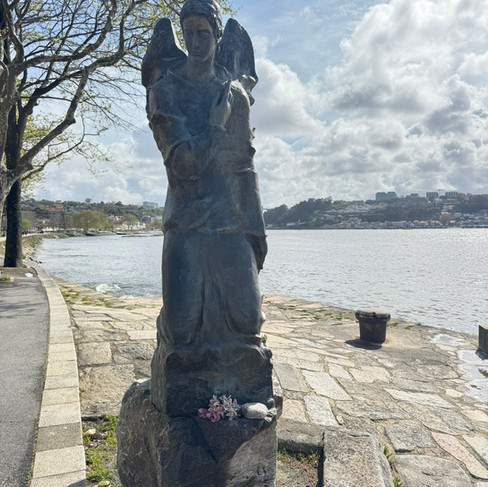























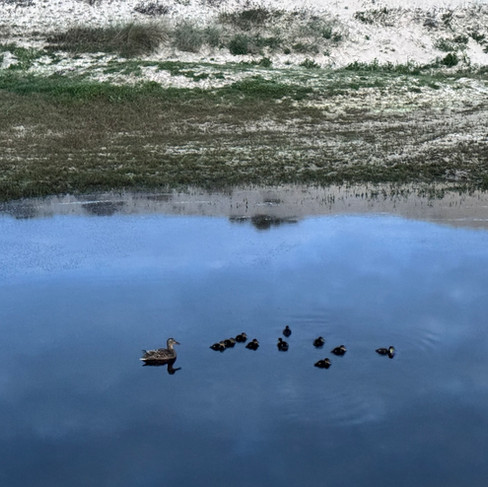







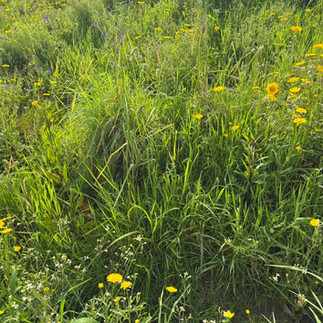



































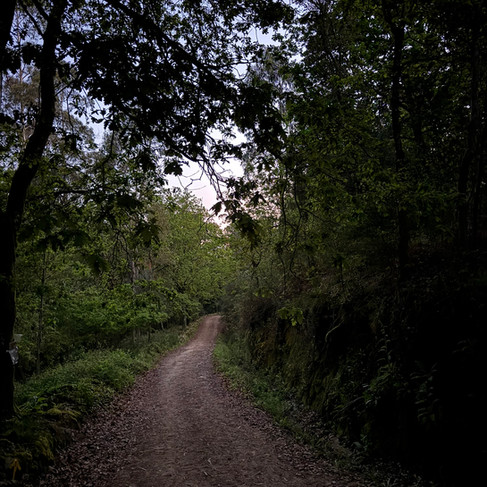







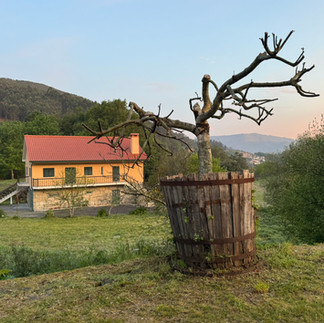



















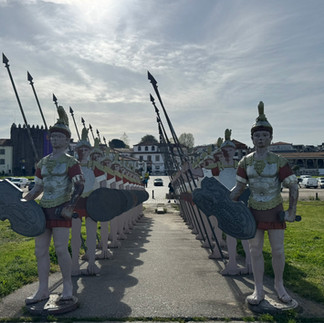










































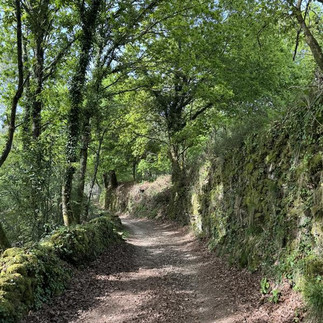























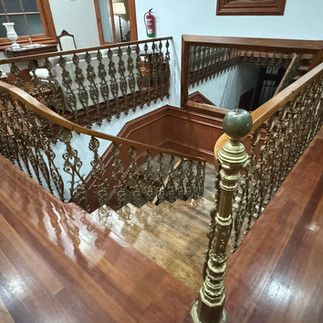











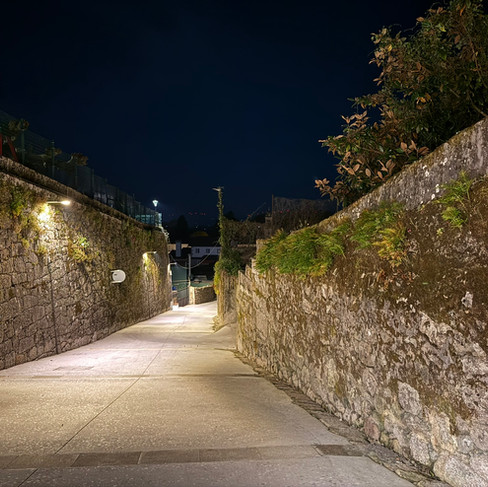













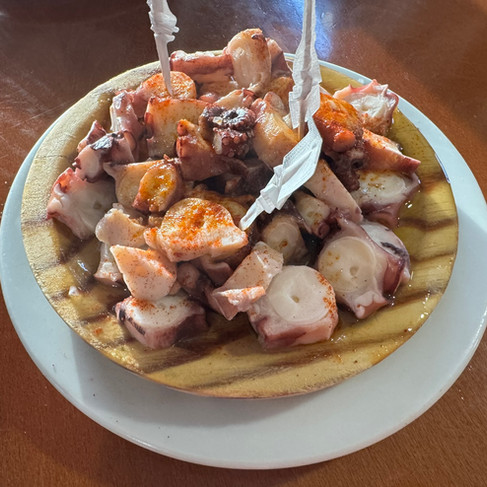









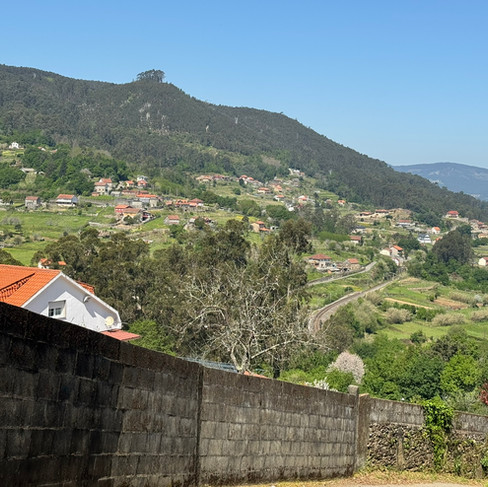

























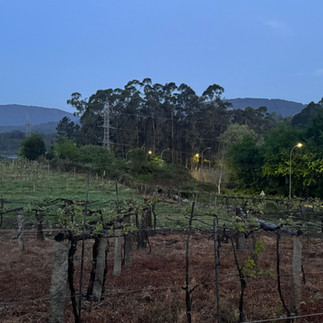









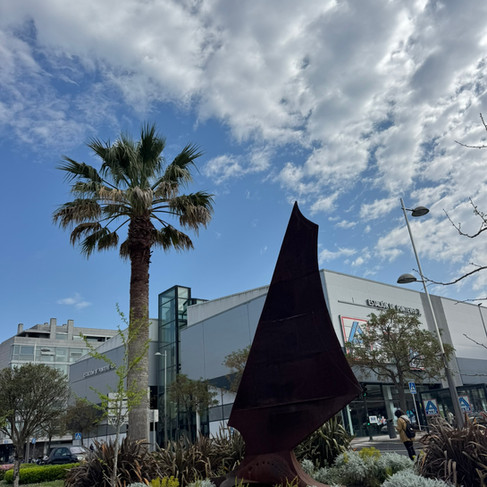









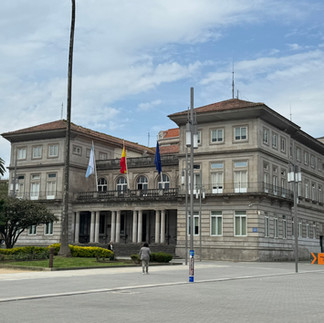











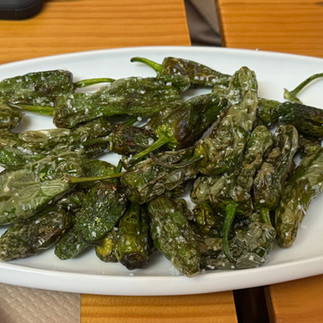









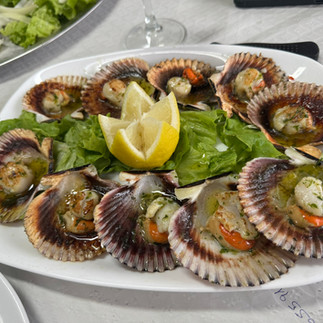



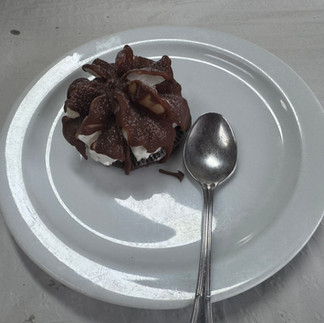





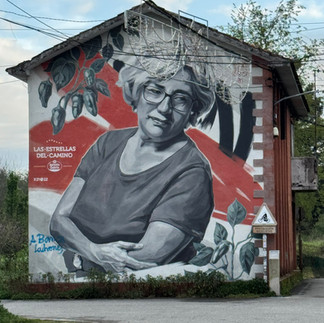







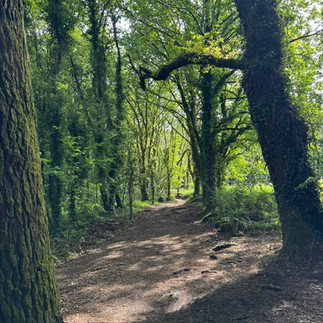























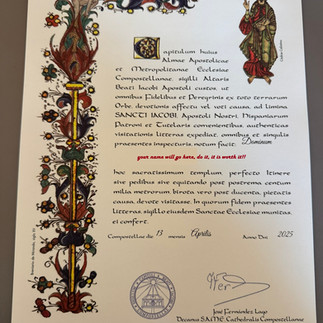

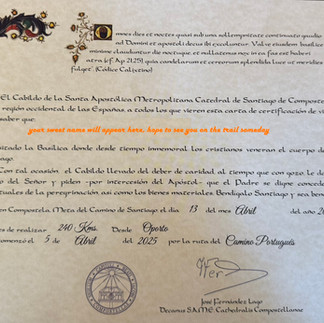

















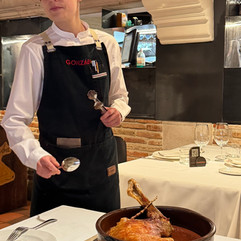









Comments